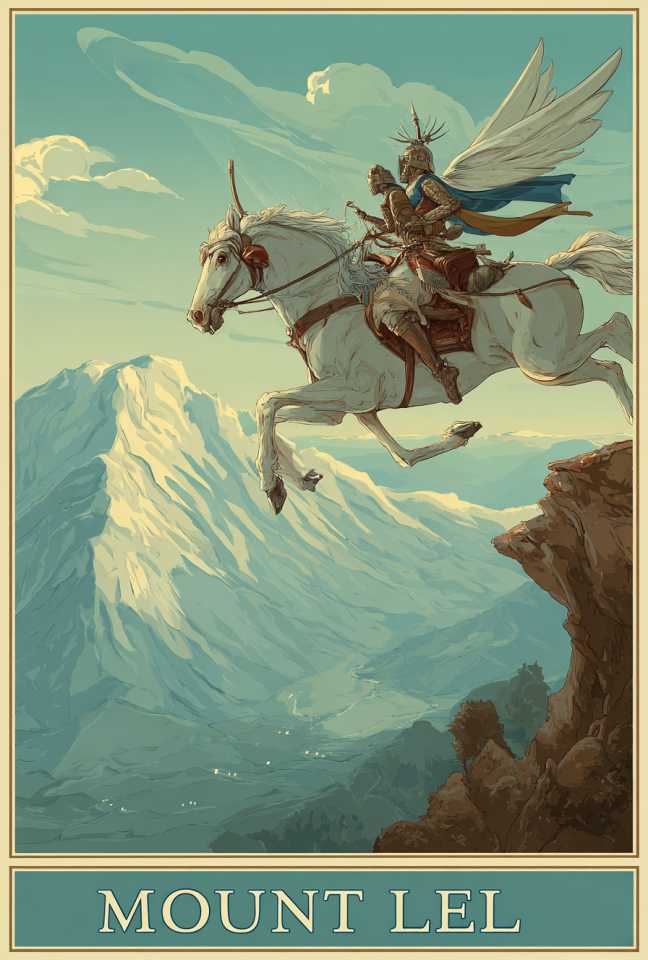Mount Lel is the high seat of divine authority and eternal threshold — the realm where sky, sea, and storm meet in a triadic balance of power. Revered by both the Phoenician and Carthaginian peoples, Mount Lel is not a terrestrial peak but a real Divine Realm that rises from the liminal place between the elements. It is the dwelling of El, the ancient father of gods, and a cosmic observation post from which seasons, treaties, and destinies are decreed. Though often remembered in fragments — in hymns to Baʿal, in oaths sworn by stars — the mountain itself lies beyond the Veil now, obscured not by time, but by the fading of covenant.
Landscape and Essence
Mount Lel rises not from stone but from equilibrium — a realm poised between firmament and abyss. Its slopes are carved from dark basalt and luminous mist, echoing with the sound of wind over deep waters. At its summit stands a great pavilion of cedar and electrum, open to all skies and encircled by celestial flame. The stars wheel visibly overhead in perfect patterns, anchoring the realm to the cycles of mortal and divine time. Around it, the four elemental domains converge: the sea hurls its tides upward from the west, desert winds spiral in from the south, the sky thunders from above, and fertile breath whispers from the east. Mount Lel does not move — but everything moves *around* it.
Inhabitants
At the heart of Mount Lel dwells El — ancient, vast, and sovereign — the All-Father whose breath shaped the order of gods. Around him, the assembly of the divine hosts convenes: Baʿal Hadad, Tanit, Melqart, Astarte, and others from both the Phoenician coast and the Carthaginian diaspora. These beings appear not as men or beasts, but as *presences* — luminous and elemental, shifting form to reflect their intent. The realm also shelters cosmic recorders, angelic scribes who track oaths and account for the seasons. Mortal souls do not dwell here, though chosen messengers have visited in fire or trance. It is not a place of rest — it is the court of enduring responsibility.
Cultural Significance
To the Phoenicians, Mount Lel was the center of divine kingship — the place where El ruled over the assembly of the gods and decided the course of seasons and storms. Temples such as those at Byblos and Tyre were built in reflection of its axis, aligning ritual action with cosmic law. In Carthage, the mountain was remembered less as a court and more as a covenant — a high place of sacrifice and renewal, where offerings to Baʿal and Tanit could momentarily lift the Veil. Though named less frequently than Olympus or Meru in later records, Mount Lel stood at the root of Semitic divine order — a summit remembered in salt, cedar, and fire.
Role in the Divine Realm
Mount Lel functions as the **axis of decree** — a neutral but sacred space where divine beings gather to negotiate, declare, and restore balance. It is not the seat of paradise, nor the forge of souls — it is the summit of law, the stage where divine order is spoken into rhythm. El sits not as tyrant but as arbiter, allowing the pantheon’s voices to convene in structured debate. Even now, beyond the Veil, Mount Lel sustains the cadence of seasons and the covenant of land and sky. Without it, the Divine Realm would drift into disorder, its cycles broken, its oaths unanchored.
Interactions with Other Realms
Once, Mount Lel could be approached from high coasts, cedar groves, and mountain sanctuaries where sea met sky. Ritual offerings of oil, incense, and first fruits could call forth echoes of its presence, and certain storms were said to carry messages from its peak. Oracles in Tyre, priestesses in Carthage, and seafarers in sacred procession reported visions of a gleaming mountaintop beyond the horizon. But as maritime routes shifted, temples were burned, and ancestral rites were suppressed, the gateways to Mount Lel fell silent. Now the summit stands veiled — not by hostility, but by the loss of alignment. Only El and the divine assembly may still ascend its slope.
















